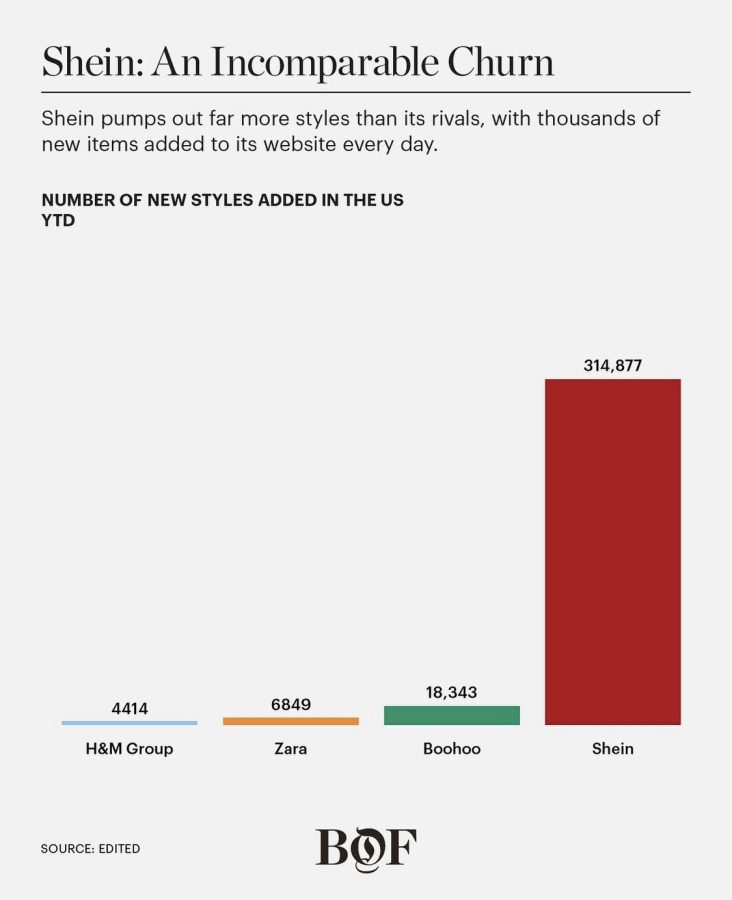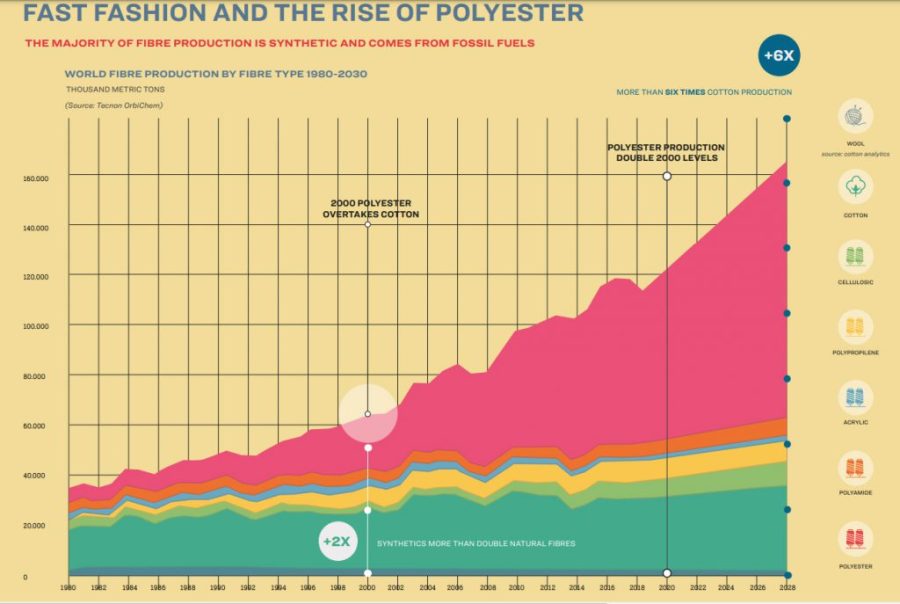
Sophie Lu is a senior at NASH. She loves reading, writing, travel, and binging The Office while eating copious amounts of purple Doritos. Outside of The Uproar, she is a member of Speech and Debate, DECA, and orchestra.
“Zara” by Leif (Bryne) is marked with CC BY-NC-ND 2.0.
The Spanish retail titan Zara has been a pioneer of the tactics used by fast fashion retailers to multiply profits.
Despite its consumer temptations, the fast fashion industry poses grave threats to both the environment and human rights.
April 20, 2022
Spring has officially sprung, and along with the blossoming flowers and trees, the runways and catwalks are also sprouting with new fashions galore. But the climate in which these styles thrive is markedly different from the past.
Gone are the days when fashionable items were only accessible to the rich and elite who could pay designer prices; now, shoppers can find trendy clothing from a large variety of fast fashion sites for remarkably low costs.
But a deeper dive into the practices these retailers employ reveals that there are hidden costs among almost every too-good-to-be-true price tag.
To begin with, textile production is an incredibly water and energy-intensive process.
It takes more than 700 gallons of water to make a single cotton t-shirt and around 2,000 gallons of water to make a typical pair of jeans, enough drinking water on average to sustain a person for nearly 11 years.
According to a UN press release, the fashion industry is the second-biggest consumer of water and is responsible for 8-10% of global carbon emissions—more than international flights and maritime shipping combined. Textile Exchange’s 2010 Global Market Report On Sustainable Textiles estimated that one trillion kilowatt-hours were used to manufacture textiles.
Fast fashion also utilizes open-loop production cycles, which means that the water from production facilities is not cleaned and reused like in a closed-loop system; instead, the polluted water is dumped directly into the environment, polluting land and waterways with toxic chemicals and metals.
The environmental impact of clothing extends way beyond production. The problem spans from conception to destruction and boils down to one theme: waste.
85% of clothing purchased by Americans ends up in landfills. Most large clothing retailers primarily use synthetic materials in their clothing like polyester, which is essentially plastic that will not decompose and perpetuates fossil fuel extraction. The fashion industry is responsible for about 20-35% of the microplastics in the ocean.
Fast fashion exacerbates these issues by the sheer amount and speed of textile production the industry utilizes, as its business model is fundamentally trend centered and consumer-driven, delivering both style and affordability to customers.
As comedian Hasan Minhaj puts it in a fast fashion-centered episode of his Netflix series, The Patriot Act, “Fast fashion is popular because it’s democratized high fashion, and they do that by knocking off designer brands at scale.”
Minhaj further explains in the segment that fast fashion companies synthesize two distinct methods to maximize their domination in the market: quick response manufacturing and dynamic assortment. The former refers to the strategy of cutting lead times at all stages of the production process in order to move product to the market as quickly as possible, hence the “fast” portion of fast fashion.
Zara can launch a product, from drawing board to storefront, in a matter of three weeks. SHEIN takes it a step further, launching in as little as three days (compare that to a normal lead time of around nine months.)

The second method, dynamic assortment, is the process of frequently changing store offerings to increase site traffic—as much as daily as opposed to the traditional few times annually. Companies are pushing new launch after launch, modeling the rapidity of their production process with that of consumer trends and demand.
The pioneers of this business model include fast fashion giants Zara and H&M, valued at $14.7 billion and $40.9 billion respectively.
The issue becomes a vicious, self-perpetuating cycle in that because the clothing is cheaply made, it is unlikely to last long and more likely to quickly be discarded. Additionally, studies of consumer habits show the low price point renders the clothing more disposable in the buyer’s mind.
In addition to the environmental detriment, the human cost of fast fashion clothing is lofty and potentially deadly. Garment workers in majority world countries earn poverty-level wages, sometimes as low as three cents an hour. The only way companies can afford to charge so little for their items is by drastically cutting labor costs.
Working in clothing factories also poses numerous occupational hazards. Workers have prolonged exposure to chemicals and synthetic dyes that can cause lung disease, reproductive risks, and even cancer. The factories themselves can also be dangerous due to lack of domestic regulation, as seen by numerous instances of disaster.
One that comes to mind is the infamous 2013 Rana Plaza factory collapse in Bangladesh, which killed 1,129 workers and injured many others. The incident demonstrates that the harrowing, Triangle Shirtwaist factory-reminiscent working conditions that have been regulated away in the West have not been eliminated, just outsourced overseas.
Psychology may explain why despite the overwhelming (and relatively well-publicized) incriminating evidence, fast fashion remains a booming sector. Unfortunately, it is human nature to be more emotionally detached from workers thousands of miles away. Even if we’re aware that they exist, it remains difficult for us to imagine their realities, so it’s easy to compartmentalize or block them out in favor of that serotonin rush from hitting “Place Order.”
But if there is one lesson about economics to be learned, it is that nothing is really free—there is always an opportunity cost associated with everything. Someone has to pay the price, and if it isn’t consumers, it is the workers or the environment.
With fast fashion becoming a hot topic in mainstream conversation circles and the heat of scrutiny beginning to shine on buyers in addition to purveyors, as more fingers are pointed, sympathy inevitably shifts. The pendulum of the fast fashion debate has swung towards the opposing direction, with a growing number of advocates pushing back against the traditional criticisms of fast fashion.
They argue that many of these critiques are rooted in elitist mindsets, as much sustainable fashion is not accessible to the vast majority of the population. Indeed, it’s a tough sell for the average consumer to choose a sustainably produced product for up to ten times the markup when there are much cheaper alternatives on fast fashion sites.
Some also argue that the popularization of thrifting, a commonly proposed alternative for affordable shopping, has contributed to “thrift store gentrification,” where increased demand raises prices to the point where low income shoppers—for whom thrift stores were originally intended—can no longer afford to buy there.
Another point is that many of the accusations posed, like the exploitation of workers and environmental impact, are not unique to fast fashion. Most products, whether they be from Nike, Louis Vuitton, or even Apple, are made with some unethical practices.
In some ways, this reaction mirrors the one that the veganism movement in modern culture faced—people don’t like feeling judged for things that bring them joy, even if their criticisms may be well-intended or rooted in truth. This is exacerbated by the fact that some of the admonishment no doubt comes from a place of condescension rather than concern.
While it is valid to criticize sanctimonious and overly-judgemental attitudes, the idea that because almost every brand is unethical it is therefore acceptable to indulge in fast fashion is fallacious. Arguing that fast fashion’s crimes can be overlooked because companies in general are flawed is akin to equating jaywalking and genocide—magnitude of impact matters, so why wouldn’t we discriminate between brands that are objectively the worst and brands that aren’t perfect but are far better?
It’s true that fully sustainable and ethical brands are diamonds in the rough rather than ubiquitous. However the worst offenders—the SHEINs of the industry, whose impacts are significantly more detrimental than the average company—do warrant environmentally and socially conscious consumers’ condemnation.
Although opinions surrounding the issue remain mixed, a significant portion of the consumer base is becoming more discerning of brands’ sustainability and ethical practices. In fact, a study shows 70% of consumers want to know how the brands they support are addressing social and environmental issues, and 46% pay close attention to these efforts when making purchase decisions.
Particularly in an age where corporate social responsibility is increasingly a selling point for many potential customers, it is in most companies’ best interest to appear ethical in the public eye (whether or not this care is genuine is a separate matter).
This has led to a rise in companies publicizing new initiatives to increase sustainability or transparency, whether it be a clothing line made of recycled materials, an in-store recycling program, or signing some sort of climate pledge.
Obviously, any steps toward companies being more socially responsible are better than nothing. However, in many of these circumstances, it seems these programs are more superficial than actually effective. In essence, their primary purpose is to boost the company’s image, not to reduce environmental impact.
Greenwashing is defined as “the process of conveying a false impression or providing misleading information about how a company’s products are more environmentally sound.” It has become a popular tactic for fast fashion companies to paint rose-colored glasses over some of their less than appealing attributes.
Take, for example, H&M’s recycling program, which allowed customers to bring in clothes that the company would then recycle into new textile in exchange for vouchers. It sounds like a good idea, but take into consideration that only 0.1% of all clothing collected by similar programs is recycled into new textiles, according to H&M’s development sustainability manager, Henrik Lampa. Compare that with the mass amount of waste and environmental harm H&M’s inherently unsustainable model generates, and what end does this program really serve?
On the flip side, there are businesses that are genuinely good models for a sustainably run business, and the difference is pretty stark compared to greenwashed corporations. Patagonia, whose 1% for the Planet pledge has been a longstanding hallmark of the company’s dedication to the environment, has in addition adhered to sustainable principles in choosing materials, offered repair services in stores, and even outright encouraged customers not to overconsume.
Yet, the bulk of the fashion industry’s attempts to pull the green-dyed wool over the public’s eyes has not stopped conscientious consumers from applying pressure to finally slow the flow of fast fashion for good.
One has to wonder, why haven’t the karmic forces of the free market corrected for fast fashion? Unfortunately, that is not what our economic system is designed to do—the reason sustainable brands are not able to dominate the market as much as fast fashion companies is that the market incentivizes underhanded practices and cut corners.
That is where the core of the issue lies. Unethical companies stay unethical because they are rewarded, whereas sustainable brands must eat the costs of more expensive materials and production costs and paying their employees a fair wage.
This proves that we can’t rely solely on consumer conscious to see our way through this climate crisis—nor should we. That’s both an unfair expectation on the average consumer as well as misdirected absolution of responsibility for more powerful bodies like the companies themselves or the government.
There are regulatory steps that can be taken to mitigate the environmental harm and incentive ethical behavior. The New York Senate recently introduced the Fashion Sustainability and Social Accountability Act, which, if passed, would mandate that retailers and manufacturers digitally publish social and environmental policies.
Much of the pushback against the sustainable fashion movement may be what many feel is a disproportionate focus on the consumer end, when they are the ones with the least power. This is a fair point to make, but the issue is clearly nuanced and, in the end, it is a problem for the consumer end as well.
“Ending is better than mending” —this line out of Aldous Huxley’s Brave New World is becoming more and more relevant the older the words are. In the UK, one in three young women (the biggest segment of consumers) consider pieces worn once or twice to be old.
It is apparent that the solution to this crisis demands a culture change too, not just a business one. And while our world is far from the futuristic dystopia of the World State (not too far, though), it will take significant action steps to prevent our future from becoming its mirror image.
Indulging in retail therapy may seem like a lose-lose situation, where there’s always an issue no matter what one does. But while it’s easy to feel powerless and give up trying altogether, there are ways that individuals can consume more sustainably as well as advocate for larger systemic change.
Tima Bansal and Gareth Gransaull, writing for the MIT Management Review, identify three distinct models of sustainable buying: resale, renting, repair. These three Rs, coupled with the traditional trio, “Reduce, reuse, recycle,” are a solid guide for a more environmentally conscious way of living.
The first R, resale, refers to the practice of buying used clothing, not necessarily only from thrift stores but also from resale apps like Poshmark, Depop, and Mercari. Secondhand is the most sustainable way of acquiring clothing, as it doesn’t involve new production. By purchasing other people’s clothing that they no longer want, users not only shop sustainably and affordably, but they also save clothes from going to a landfill.
Additionally, renting clothes is another way in which people can decrease their consumption. Platforms like Rent the Runway and Nuuly allow users to rent trendy clothing for a fraction of the retail price and are perfect for clothing that is only going to be worn for a specific occasion.

Finally, the most simple but perhaps most effective method to curb excessive consumerism is merely wearing clothes for longer. Instead of tossing pieces when trends inevitably shift, practicing intentional buying and limiting impulse purchases turns out to be healthier for the environment and your wallet.
For those who can afford it, investing in sustainable brands proves to be a worthwhile endeavor in the long run. Unlike fast fashion items, sustainable clothing is built to last numerous fashion cycles. Paying more for a few high quality, timeless pieces will be cheaper long term.
There are many aspects of retail shopping that common consumers are powerless to control, but that means they are especially responsible for what they do have power over.
Shoppers are not obligated to be perfect, but they should feel obligated to do their best. If there are changes they are capable of making in their purchasing habits, the businesses they choose to support, and the use they get out of each piece, it is our duty as a society to do better.

Sophie Lu is a senior at NASH. She loves reading, writing, travel, and binging The Office while eating copious amounts of purple Doritos. Outside of The Uproar, she is a member of Speech and Debate, DECA, and orchestra.
Susan • May 9, 2022 at 10:44 pm
Great article! We all need to do better.